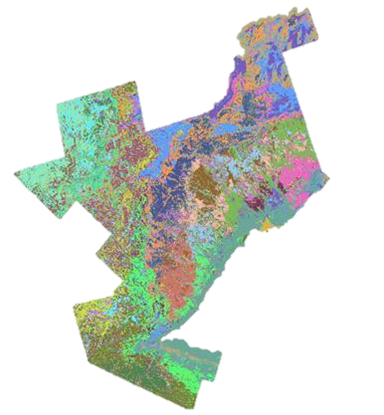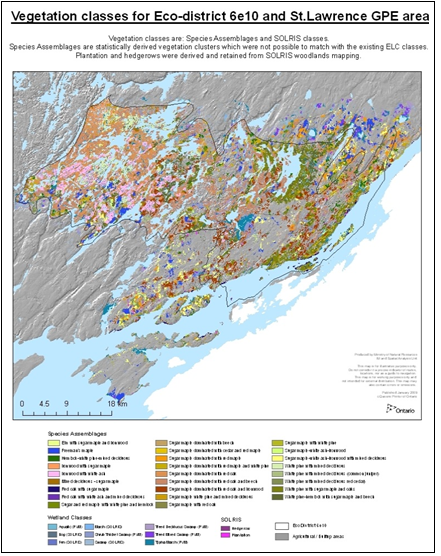 Predictive
vegetation maps serve as decision
making tools and provide critical information for many landscape
planning and
management activities. Vegetation boundaries traditionally used to
create maps can be produced in a number of
different ways by digitizing / outlining vegetation boundaries,
classifying
remotely sensed images, or by developing predictive models.
Predictive
vegetation maps serve as decision
making tools and provide critical information for many landscape
planning and
management activities. Vegetation boundaries traditionally used to
create maps can be produced in a number of
different ways by digitizing / outlining vegetation boundaries,
classifying
remotely sensed images, or by developing predictive models. Predictive vegetation modeling can be defined as “predicting the geographic distribution of the vegetation composition across a landscape from mapped environmental variables” (Franklin 1995). Predictive vegetation modeling “is founded in ecological niche theory and vegetation gradient analysis” (Franklin 1995, p. 475) and thus, maps environmental variables as they correspond to environmental gradients.
Predictive geographical modeling can be defined as the “quantification of species-environment relationship done in conjunction with GIS” (Guisan and Zimmermann 2000).
Regardless of the definition, predictive vegetation modeling has enabled vegetation mapping to evolve from traditional drawings of vegetation type boundaries to remote sensing image classification, capable of modeling species and vegetation distribution, vegetation structure and vegetation characteristics across different spatial and temporal scales.
We use predictive vegetation modeling to model historical, present, and future vegetation and species distribution. We also use it to model and map ecological goods and services (e.g. carbon biomass) and other vegetation characteristics (e.g. floristic quality, vertical structure, quality / health of vegetation). Modeled historical vegetation enables us to go back in time and understand what the landscape looked like.
Predictive modelling may utilize different models and combinations of variables. Statistical modeling techniques can be used to model and predict the distribution of vegetation across a landscape.

Modeled historical vegetation:
Modeled present day vegetation:
- Regional Municipality of York (Puric-Mladenovic, D. 2003)
- Digital atlas of predicted species distributions, vegetation assemblages and habitat characteristics for the eco-district 6e10 and GPE – St. Lawrence Islands National Park, version 1.0 (Puric-Mladenovic, D., Buck, J., David Bradley, Arends, R., and Strobl, S. 2008)
Biomass and carbon predictive modeling and mapping:
Species distribution and predictive modeling:
- Probability of Habitat Suitability for Dwarf Lake Iris
- Probability of Habitat Suitability for Hill's Thistle
- Predicted abundance of sugar maple for the eco-district 6e10 and GPE - St. Lawrence Islands National Park ( Puric-Mladenovic, D, Buck, J., Bradley, D., Arends, R., Strobl, S. 2008)
Modeled invasive species distribution:
Modeled species distribution under future climates:
Example: Modeled sugar maple presence and absence in the Lake Simcoe watershed for four climate periods
- Projected tree distributions, tree migration rates, and forest types in Ontario under a 2°C global temperature rise
- Implications of climate change on disturbance regimes, carbon stocks, management and biodiversity of Canada’s boreal forests
Applications of Predictive Vegetation Maps
Predictive vegetation maps have different applications that range from forest restoration, conservation, and management to land use planning. Some of applications are the design of green systems and landscape planning, informing restoration, protection and recovery of species at risk and their habitats, and supporting conservation efforts and natural resource management.
In settled landscapes, detailed vegetation maps are used to support diverse management, planning and conservation needs. This can include planning and management decisions, at both the patch and landscape scale, related to forestry and silviculture; fire management; pest and invasive species management; park management; recreation; wildlife habitat modeling and population analysis; natural heritage systems planning; municipal land use planning; education; research; Species at Risk recovery planning; and climate change mitigation and adaptation.
A methodology has been developed that leverages and combines strategic field campaigns using VSP, existing spatial and environmental data, and statistical modeling. This methodology is designed to be carried out in partnership with organizations that can provide the expertise and support to conduct field work.
For example, using VSP field data along with environmental and spectral remote sensing data, it was possible to statistically model over 180 vegetation maps for Ecodistrict 6E-10 (see figure below). The series of maps developed included detailed information about individual plant species, forest conditions (e.g. canopy closure, basal area), and types of forest and wetland vegetation communities.
Click the link below to open the project’s website within Land Information Ontario (LIO):
Digital atlas of predicted species distributions, vegetation assemblages and habitat characteristics for the eco-district 6e10 and GPE – St. Lawrence Islands National Park, version 1.0 (Puric-Mladenovic, D., Buck, J., David Bradley, Arends, R., and Strobl, S. 2008).

Vegetation classes for Ecodistrict 6e10 and St. Lawrence GPE area. OMNR 2009.
Click on Thumbnail for Enlarged Map